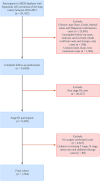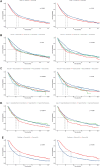Survival benefit of postoperative chemotherapy in stage III lung squamous cell carcinoma based on SEER database analysis through propensity score matching
- PMID: 40596657
- PMCID: PMC12217666
- DOI: 10.1038/s41598-025-07766-0
Survival benefit of postoperative chemotherapy in stage III lung squamous cell carcinoma based on SEER database analysis through propensity score matching
Abstract
Lung squamous cell carcinoma (LUSC) is a prevalent subtype of lung cancer. This retrospective cohort study aims to explore the effect of postoperative chemotherapy on survival in patients with Stage III LUSC and to assess its heterogeneity across different patient subgroups. Patients diagnosed with postoperative Stage III LUSC between 2010 and 2015 were identified in the Surveillance, Epidemiology, and End Results (SEER) database, and cases with missing information were excluded. The primary outcome measure was overall survival (OS). Propensity score matching (PSM) was employed to balance confounders. Kaplan-Meier (KM) curve was used to assess the OS of patients in different groups. The prognostic risk factors of patients with OS were screened and analyzed through Cox regression analysis. The cohort consisted of 1,784 patients (65.3% receiving chemotherapy), and postoperative chemotherapy was associated with a modest survival benefit: the adjusted hazard ratio (HR) was 0.62 (95%CI: 0.55-0.69, P < 0.001), corresponding to an absolute 5-year OS improvement from 28% (Non-chemotherapy) to 42% (Chemotherapy). Overall, no significant difference was observed in OS between the PSM group and the non-PSM group, except for the variable tumor size, which became significant for OS after matching. Subgroup analyses revealed that chemotherapy improved survival for patients across nearly all characteristics. Univariate and multivariate Cox regression analyses identified marital status, race, gender, and age as significant prognostic factors influencing OS. In conclusion, postoperative chemotherapy significantly ameliorates the survival in most patients with Stage III LUSC, with the most pronounced effects observed in those with N1-2 stage disease and undergoing resection of the lobe, bilobectomy, or pneumonectomy. Our findings provide valuable insights for clinical decision-making and related studies on the application of chemotherapy in patients with Stage III LUSC resection.
Keywords: Chemotherapy; Lung squamous cell carcinoma; Phase III; Propensity score matching; SEER database.
© 2025. The Author(s).
Conflict of interest statement
Declarations. Competing interests: The authors declare no competing interests. Ethical statement: The authors are accountable for all aspects of the work in ensuring that questions related to the accuracy or integrity of any part of the work are appropriately investigated and resolved. Patient and public involvement: Patients and/or the public were not involved in the design, conduct, reporting, or dissemination plans of this research.
Figures





Similar articles
-
The effect of postoperative adjuvant chemotherapy on survival outcomes in patients with early stage oral squamous cell carcinoma.Sci Rep. 2025 Jul 25;15(1):27157. doi: 10.1038/s41598-025-11565-y. Sci Rep. 2025. PMID: 40715317 Free PMC article.
-
A SEER-based prognostic nomogram for early-stage (pT1-2N0M0) tongue squamous cell carcinoma and an observational analysis of postoperative radiotherapy.World J Surg Oncol. 2025 Jul 25;23(1):302. doi: 10.1186/s12957-025-03883-2. World J Surg Oncol. 2025. PMID: 40713628 Free PMC article.
-
Prognosis of non-small cell lung cancer patients undergoing compromised wedge vs. segmental resection: a population-based cohort study.J Cardiothorac Surg. 2025 Aug 12;20(1):334. doi: 10.1186/s13019-025-03578-5. J Cardiothorac Surg. 2025. PMID: 40796892 Free PMC article.
-
Impact of residual disease as a prognostic factor for survival in women with advanced epithelial ovarian cancer after primary surgery.Cochrane Database Syst Rev. 2022 Sep 26;9(9):CD015048. doi: 10.1002/14651858.CD015048.pub2. Cochrane Database Syst Rev. 2022. PMID: 36161421 Free PMC article.
-
Postoperative adjuvant chemotherapy in rectal cancer operated for cure.Cochrane Database Syst Rev. 2012 Mar 14;2012(3):CD004078. doi: 10.1002/14651858.CD004078.pub2. Cochrane Database Syst Rev. 2012. PMID: 22419291 Free PMC article.
References
MeSH terms
LinkOut - more resources
Full Text Sources
Medical
Miscellaneous

